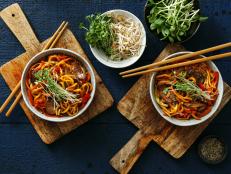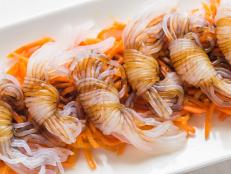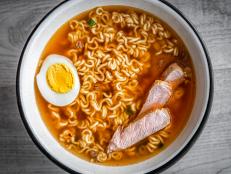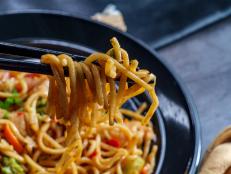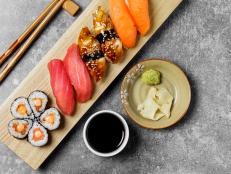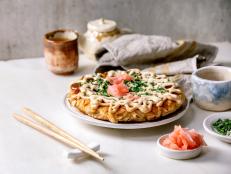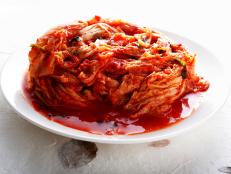What Is Pho? Its History, Ingredients and How to Eat It
According to the owner of a popular New York City-based pho restaurant.

Matt
By Layla Khoury-Hanold for Food Network Kitchen
Layla Khoury-Hanold is a contributor at Food Network.
For many Americans, pho is synonymous with Vietnamese food. But there’s more to this dish than noodles, broth and toppings. Chef Jimmy Ly, who, along with his wife, Yen Vo, co-owns New York City restaurants Madame Vo and Monsieur Vo, weighs in.

Lisovskaya/Getty Images
What Is Pho?
Pho is a Vietnamese dish of slow-simmered broth, typically prepared with beef bones, served with rice noodles, protein (such as beef, chicken or plant-based protein) and toppings. Pho is the national dish of Vietnam and a beloved comfort food that evokes nostalgia for many Vietnamese people. “It’s a dish that came to America with our parents, who fled Vietnam as refugees,” Ly says. “It’s nostalgia, love and warmth in a bowl.”
Pho most commonly refers to pho bo, or beef pho. “Typically, pho bo is made by simmering beef bones with some cardinal spices like star anise, cardamom, coriander, clove and cinnamon. These aromatics layer on top of the savory notes of the beef, which is typically simmered for over 12 hours. We do it for 24,” Ly says. “It’s a labor of love, but we feel it is totally worth it because the flavor is that much more amplified.”
Pho is the signature dish at Madame Vo and is made according to a blend of recipes from both Ly and Vo’s families. The broth recipe is from Ly’s mom, and the addition of succulent short rib is Vo’s mom’s contribution. “As a kid, Yen would always add extra meat to her pho, so we give our guests the option to enjoy it the same way,” Ly says.
Pho Pronunciation
With Vietnamese diacritics, pho is spelled phở. “It’s pronounced “fuh,” rhyming with “duh,” Ly says.
What Is the History of Pho?
Although the origin of pho is still unclear, some experts posit it derived from the French dish pot-au-feu, because of its similar pronunciation and some common ingredients, such as slow-simmered beef. Other experts believe that the inclusion of rice noodles points to Chinese influence. “It was made in Vietnam, by Vietnamese people, who often had to work with what they had in the face of invasion and colonization from both the Chinese and the French,” Ly says.
Ly adds that, during French occupation, pho was regarded as more of a luxury. “But nowadays in Vietnam it is seen as something you could have more than once a week,” he says. “For Vietnamese Americans, it’s also a reliable go-to for those missing a taste of home.”

OsakaWayne Studios/Getty Images
Types of Pho
There are several types of both broth-based and broth-less pho.
Broth-Based Pho:
- Pho Bo: beef pho
- Pho Ga: chicken pho
- Pho Chay: vegetarian pho. “We offer an awesome version of pho chay loaded with seitan and mushrooms, but some people even put carrots and broccoli in theirs,” Ly says.
Broth-Less Pho:
- Pho Sate: Ly describes this dish as “sort of like rice noodles with beef gravy.” It is made with tuong ot sate, a Vietnamese chile sauce with garlic and lemongrass.
- Pho Kho: also known as dry pho, pho kho is a popular street dish in Vietnam (as well as in Houston, where Vo lived prior to moving to New York City). The version served at Monsieur Vo is made with chicken and many of the same aromatics as its broth-based counterpart. “We also add chicken liver for extra savory goodness,” Ly says.
Regional Differences In Pho
How pho is prepared and served can vary by region too. “We would describe our version of pho as southern-style, which typically means big, bold flavors thanks to all the spices but also umami from fish sauce and sweetness from rock sugar,” Ly says. “The northern Vietnamese variety of the dish is a bit more simplified, with a more clear and less rich broth. In the south, pho is also typically served with lots of herbs and garnishes which can range from Thai chilies and jalapenos to fresh mint, basil and cilantro.”

Matt Armendariz
Ingredients In Pho
Protein: The protein in pho is often beef, such as chuck roast, brisket or flank steak, but sometimes includes chicken, pork, seafood or tofu.
Noodles: The flat rice noodles are called banh pho.
Aromatic broth: The broth is bolstered by fish sauce and seasoned with spices such as star anise, cloves, cinnamon, coriander seed, fennel seed, whole green cardamom pods, whole fructus amomi and rock sugar. Ly’s broth ingredient list, inspired by his mom’s recipe, also includes choice cuts of meat such as beef brisket or chuck short rib, to make his restaurant version standout. “Typically, it’s the proportion of ingredients and the techniques (parboiling, skimming the fat, etc.) that makes the final difference between different people’s recipes,” Ly says.
For this Instant Pot Beef Pho (pictured above), the stock time is cut down to three hours thanks to the pressure cooker technique. The hot, steamy broth cooks the accompanying slices of raw sirloin to a meltingly tender texture.
Toppings: The bowl is topped with fresh mung bean sprouts, thinly sliced red onion, jalapeno slices, Thai basil and lime.

Oscar Wong/Getty Images
Traditional Pho Toppings
Standard toppings include:
- Scallions, sliced into small rings
- Onion, thinly sliced
- Bean sprouts
- Cilantro
- Thai basil
- Limes
- Hoisin
- Sriracha
How to Eat Pho
“A lot of people tend to hold chopsticks in one hand, a deep soup soon in the other, and then twirl some chopsticks onto the spoon with some broth and a slice of meat. That’s the perfect bite!” Ly says. That said, how to eat a bowl of pho is somewhat subjective in terms of how and when you add your toppings and what other sauces you like to mingle in. Vo likes to squeeze fresh lime into a dipping cup with hoisin and Sriracha to make a sauce. Some people like to dip theirs into that sauce before mixing it back into the noodles, while others prefer to add chili oil or salt. Ly notes that southerners tend to pile their herbs into the broth, while northerners use fewer garnishes to preserve the purity of the broth. Generally speaking, Ly says that it’s okay to slurp pho.
Is Pho Healthy?
Within Vietnamese culture, pho is regarded as a restorative and nutritious dish. “Pho has always been my family’s solution when one of us was sick. Loaded with nutrients and topped with herbs, it’s a nourishing meal that can at best cure hangovers, if nothing else,” Ly says. “Some of the fragrant spices, like cinnamon and clove, add a sense of warmth.
Is Pho Gluten-Free?
Yes, pho is generally considered a gluten-free food. As long as the rice noodles are made with 100% rice and the broth and toppings don’t contain gluten, pho is gluten-free.
Related Links:
























